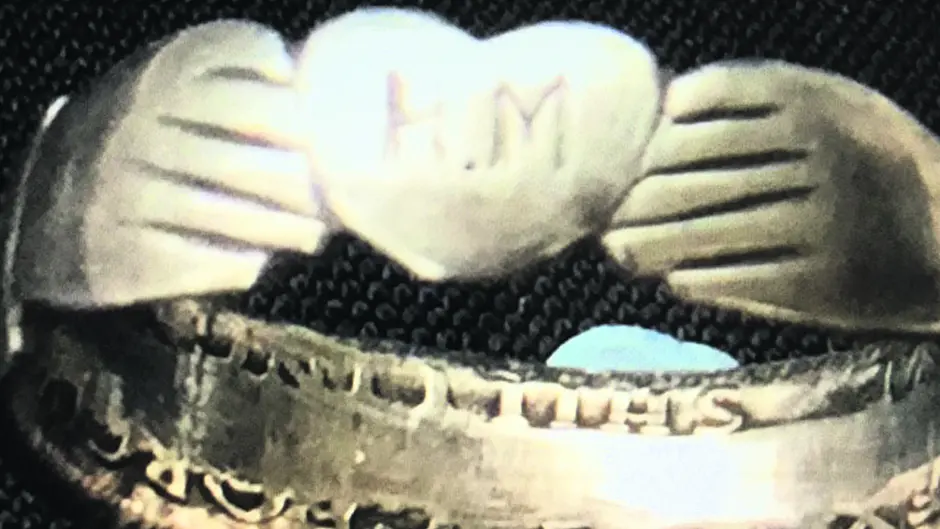The legacy of a West Cork man, who was interned on Spike Island for a time during the War of Independence, now lives on in a Fenian Claddagh ring he crafted out of an English shilling.
On December 8th 1921, two days after the signing of the Treaty, James Ryan – who was better known as a detective in Clonakilty – was released from Spike Island where he had been interred for six months.
During that time James and the other inmates were permitted to spend their time crafting iron and woodwork, as well as writing songs and poems.
‘Dad used an English shilling to make a Fenian Claddagh ring for my mother who was his girlfriend at the time,’ said said Carmel Ryan, his daughter, who still lives in Clonakilty.
‘My mother told me that family members could send in polish for their boots and that’s how the shilling was smuggled in.’
A Fenian Claddagh ring does not have the crown on top. And on the heart James inscribed HM, the initials of his lady love, Hannah Murphy.
To this day, Carmel said the inside of the ring, which is now 100-years-old, still shows markings of the old shilling.
She said it was only after his death that her mother opened up about his past and, in recent months, leading up to the centenary, Carmel did some digging of her own.
Carmel learned that her paternal grandparents emigrated from Co Kilkenny, and that James, otherwise known as Jimmy, was born in Brooklyn in January 1891.
The family returned to Ireland in 1897 to take over the running of the family farm at Graiguenamanagh.
It was in July 1916 that James joined the Irish Volunteers, which became very active a year later when the British government tried to extend conscription to Ireland.
The Volunteers engaged in extensive training. They collected shotguns and ammunition, which they kept in storage, and formed battalions.
James was elected first lieutenant of A Company in Graiguenamanagh in the South Kilkenny 4th battalion.
It was in August 1920 that the company discovered a British army informer. A court martial found him guilty and the company agreed to execute him by drowning.
‘My dad and two other men were part of the court martial proceeding,’ said Carmel, ‘and they called the local priest to give him his last rites.
‘Tied, gagged, and with a weight attached, they dropped him in the River Barrow only for the decomposed body to resurface two months later,’ she said.
More weights were attached and they dropped the body back into the river. However, someone related the incident to the Auxiliaries and the company captain went on the run.
James Ryan then became captain and his home place became the headquarters for the IRA from 1919 to 1921.
‘It was a real hub for meetings and for storing arms,’ said Carmel. ‘On one occasion, the Black and Tans raided their house looking for my dad and his brothers.
‘They found nothing. However, in 1997, when the home place was being renovated, guns were found hidden up the chimney.’
The family also found crosscut saws, which were used for cutting trees to block roads, and, while clearing the garden at the back of the house, they found a large quantity of rusty guns. In early December 1920, the Auxiliaries went in search of James, who tried to make a run for it across a field.
When they fired at him the bullet bounced off the clasp of his braces before he surrendered.
The Volunteers heard the shooting and set up a position in which to ambush them, but the Auxiliaries returned a different route.
The Volunteers had also mined a local bridge but they couldn’t blow it up when they saw Carmel’s father sitting in the back of the lorry.
As a prisoner, James was beaten, blindfolded, put on the top of the lorry and paraded him around the town as an example to others.
He was sent to Kilworth army camp and from there he was sent to Cork where, at the age of 30 and as a US citizen, he was interned on Spike Island on June 9th 1921.
After the Treaty, James was appointed as an officer when he signed up to the Free State Army in 1922.
‘He was a supporter of Michael Collins, and worked with William T Cosgrave,’ said Carmel. He was a recruiting officer in Graiguenamanagh and when the Civil War ended in May 1923, he was demobilised in October.’
It was in March 1925 that James joined An Garda Siochana and served in Sligo, as well as Kevin Street in Dublin.
In 1928, he transferred to Cobh, and, in August 1929, he married Hannah Murphy.
He was subsequently transferred to Clonakilty, where he served as a garda detective from 1942 until his retirement in 1953.
He was very well respected in the area and died peacefully at home in January 1965.
Carmel confirmed that both James and his brother Johnny were each awarded a medal of honour by the late President Erskine Childers for their efforts to free Ireland.








